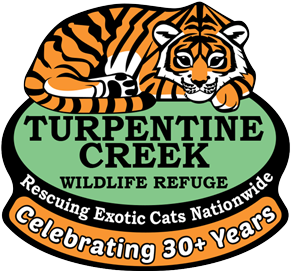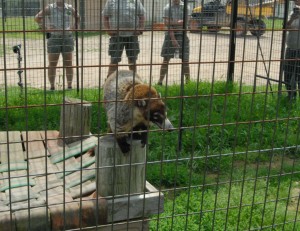Wednesday was a great day to be a coatimundi. For years, Turpentine Creek Wildlife Refuge’s sole coati, Flip, has been dwelling in a concrete habitat behind the gift shop in the old compound area, bringing smiles to the faces of every visitor to the refuge.
But that changed Wednesday, when Flip was moved into her own grassy habitat for the first time. The area, next to the main office and adjacent to the Siberian and Bengal suites, has fencing that goes a foot into the ground, to prevent her digging out.
“We used to give her tubsful of dirt to dig in, earthworms to find, in her old enclosure,” says Curator Emily McCormack. “Coatis love to dig for worms. Now she can do it for real.”
Coatis are cousins to the raccoon family and are native to South America, Central America, and south-western North America. They are omnivores, eating both meat and plants. In the wild, they eat fruits, berries, insects, birds, eggs, lizards, and even snakes and small mammals like mice and squirrels. They use their long, probe-like nose for searching through leaves, crevices, and holes to find their favorite foods. The long claws on their feet are good for tearing apart rotting logs.
“In 2009, we received an email from a man representing a facility formally open to the public in Branson,” McCormack says. “Because of some problems, they had to part with seven big cats, a black bear, and a coatimundi – Flip — to be eligible to reopen to the public. So she came to us. In Branson, she was forced to exist in what was intended as a reptile habitat, concrete and glass. We were glad to get her out of there, and we’re even happier now to give her her own big grassy habitat.”
Flip seems to agree.

